2014 Yamaha SR Viper XTX SE Review – Video

Yamaha breeds a backcountry powder player
It’s called pow pow, or simply, pow. If you like riding in the powder, then you know what I mean. Yamaha has given you pow pow hunters reason to get your powder hunting license and go at it. Going deep with the 2014 Yamaha SR Viper XTX SE, a new crossover snowmobile from Yamaha, is taking advantage of Yamaha’s proven four-stroke technology in its new SR Viper Chassis, which will be familiar as it’s the ProCross chassis from Arctic Cat.
Engine Type:Horizontal In-line
Cylinders:3
Engine Stroke:4-Stroke
Valve Configuration:DOHC
Displacement:1049 / 64
Starter:Electric
Turbocharged:No
View Full SpecCrossover snowmobiles deliver winter fun in two ways, (1) trail comfort and control, and (2) deep powder-in-the-meadows finesse. Crossovers have gained, and continue to gain much popularity over the trail-specific short trackers, due in part to an aging rider population. A crossover’s longer rear suspension, 20- to 10-inches longer or more than that of the 121-ish to 130-ish snowmobiles, provides a more plush, less choppy ride, due to the fact the longer rear skid frame glides over many more moguls, rather than falling into them like the short tracks.
Get the Flash Player to see this player. |
There has been much written about the technology- and product-sharing venture between Yamaha and Arctic Cat. Wade West, Media Relations Manager for Yamaha Snowmobile, USA, told Snowmobile.com “Though Yamaha and Arctic Cat have entered into an agreement to share some technology, whereas Arctic Cat purchases Yamaha’s 1049 motor, and Yamaha purchases Arctic Cat’s ProCross chassis, the two companies will remain separate and distinct companies.” This statement became highly apparent when we chronicled Arctic Cat’s XF 7000 Cross Country.
The SR Viper XTX SE shares the same motor as Yamaha’s other crossover snowmobile, the FX Nytro XTX – XTX is the label for all Yamaha’s crossovers. The motor, the grunt-filled four-stroke three-cylinder, 1049cc high-performance Genesis, is a one that has a solid history of dependability and fits nicely in the SR Viper XTX; literally a turnkey motor.
COMPARE: 2014 Arctic Cat XF 7000 Cross Country Sno Pro Review – Video
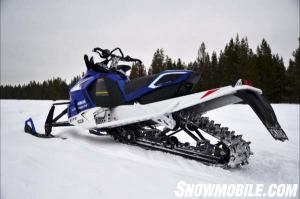 The 15-inch wide, 141-inch long Camoplast Cobra track with 1.6-inch lugs provides plenty of bite for the trails. The long skidframe makes choppy trails comfortable.
The 15-inch wide, 141-inch long Camoplast Cobra track with 1.6-inch lugs provides plenty of bite for the trails. The long skidframe makes choppy trails comfortable.
For years we at Snowmobile.com have ridden the FX Nytro MTX and XTX and we know the motor runs fast as it stretches out, but for this time, the Viper XTX seemed to drop off, which was uncharacteristic.
When we took the SR Viper XTX to the backcountry, we found the 1.6-inch track to be sufficient for some mildly deep snow, but it could use some taller lugs. The SR Viper XTX would do well with a 1.75-inch track – it has the power. With the shorter lugs and bottom-end hard clutch hit, it would blow out its track. The chassis is designed for good flotation, and we feel a mellower engagement and taller track would benefit the crossover rider who yearns for deep powder and more backcountry exploring.
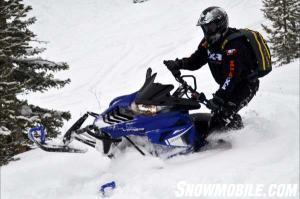 Test Rider, Kevin Allred takes the Viper XTX through some Montana deep powder.
Test Rider, Kevin Allred takes the Viper XTX through some Montana deep powder.
The Viper XTX has great ergonomics. Its seat-to-handlebar feel and reach are superb. The seat is long enough to stretch out on and has just enough grip to tie the rider down, but not so much to prevent the rider from positioning on the seat for right- and left-turn cuts. The windshield and hood provide good wind protection and move the snow around the driver when plowing the deep. The Viper XTX’s runningboards are stiff, appropriately sized for a heavy boot, and they do evacuate the snow. The Viper’s platforms are a vast improvement other the boards on the Nytro XTX where its snow evacuation holes are not as large.
We like the bold colors, the solid blue and red. The blue, Yamaha’s traditional color is appealing, but the brash solid red Viper XTX really stands out as an image-maker.
RELATED: 2014 Yamaha SR Viper Review
When we rode the SR Viper XTX, we did not feel we were on an Arctic Cat-supplied and Yamaha-purchased chassis; we felt like this was all Yamaha. Anyway, this feel came from the familiar power and sound from the Yamaha 1049. Its unique hum and Yamaha’s method to clutching – hard hit – and Yamaha’s approach to shock compression and rebound, the Viper XTX had Yamaha’s fingerprints all over it.
The SR Viper XTX’s shocks were set to be stiff. It was dialed in for choppy trails with harsh flat top moguls that challenge rider and sled. The SR Viper XTX performed best when rolling through the junk at half throttle where the SR Viper chassis skipped the tops. If slower, the SR Viper XTX would fall into the holes and the stiff shocks would feed the highs and lows up through the handlebars. But, as you know, shock pre-load and valving can cure this – it’s always smart to be a tuner and prep your sled for body weight and riding style. For this day as we rode the XTX, with ample throttle the XTX would smooth out and glide over the tops.
The SR Viper XTX chassis is a two-piece tunnel made up of an inner- and outer-formed shell with a boxed support structure to make up the two-piece tunnel. This gives the chassis strength. The tunnel is also tapered – tear drop style – from front to tail, giving the snowmobile a skinny feel for the rider. This helps the Viper XTX propel through the deep snow. Continuing, the chassis uses triangulated spars that increase rigidity and reduce chassis weight over that of the FX Nytro.
The SR Viper XTX’s front suspension, with tall spindles is known as SRV. It uses Fox FLOAT 2 shocks and has up to 10-inches of travel. Ski stance is an adjustable 42-43 inches. The rear suspension is known as Dual Shock SR 141, where it uses Fox Zero Pro on the rail’s front and a Fox FLOAT 2 on the rail’s rear. Travel is reported at 14.5-inches. The Camoplast Cobra track is 15-iches wide, 141-inches long with lugs that are 1.6-inches, as earlier stated.
If you are considering a crossover snowmobile, then here is a solid choice. The Yamaha 1049 motor is a reliable three-cylinder electronic fuel-injected four-stroke that delivers 135 sea level rated horsepower. It is a motor that requires very little attention.
The chassis has proven itself in the Arctic Cat XF Cross Country line and has no bad habits.
We figure by the time the SR Viper XTX hits the showroom floors, Yamaha will have its drive and driven clutches properly set for this chassis, as it is wholly different from the FX Nytro XTX. Yamaha is a company that has a heighted sense of quality control. Also, ask your dealer to set up the shocks to your riding style, this makes the sled uniquely yours. Lastly, for me, I would change out the ski for Yamaha’s powder ski; that’s just me as I am a deep pow pow rider.
RELATED: 2014 Yamaha Viper LTX SE Review – Video
The technology transfer between Yamaha and Arctic Cat is a win-win here. When Suzuki and Kawasaki hooked up to share tech on their off-road dirt bikes, the companies’ four-stroke models jumped forward in quality and customer appeal, the same will be true here, I believe. We live in a global market, and the snowmobile world across the vast Pacific Ocean and the plains in the Midwest have joined together. That means for you, a blue or red SR Viper XTX that is a blend of American get-er-done with Japanese patience for quality. Thus your pow pow crossover experience will be get-er-done, but patiently.
| 2014 Yamaha SR Viper LTX SE | |
| Engine | Yamaha Genesis 1049cc four-stroke triple with 3x41mm throttle body electronic fuel injection; 3-into-one canister exhaust at port side exit |
| Horsepower | 130 (estimated) |
| Drive | Yamaha YVXC drive and driven |
| Front Suspension | SRV Dual A-arm with Fox Float 2 shocks; up to 10.0 inches of travel |
| Rear Suspension | Dual Shock SR 141 parallel slide rail with aluminum body Fox Zero Pro and Fox Float 2 shocks; up to 14.5-inches of travel |
| Brake | Hayes hydraulic brake system mounted to driveshaft |
| Length | 125.0 in |
| Width | 48.0 in |
| Ski Stance | Adjustable from 42-43 inches |
| Track | 15 x 141 x 1.6 Cobra |
| Weight | N/A |
| Fuel Capacity | 10.6 US Gal (Regular fuel) |
| Features | Digital gauge, tool bag, push button reverse, electric start, mountain strap |
| MSRP | US$12,999 |



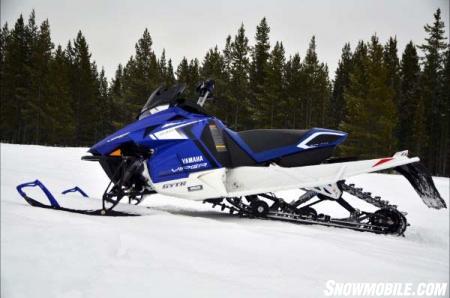
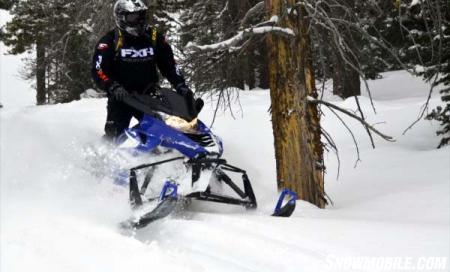
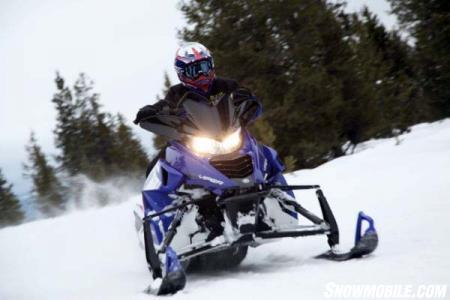
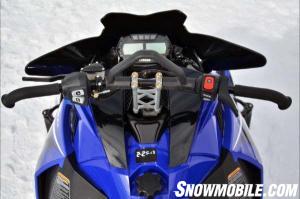
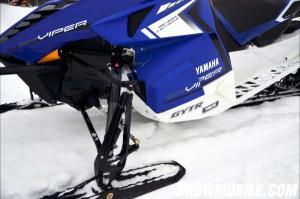
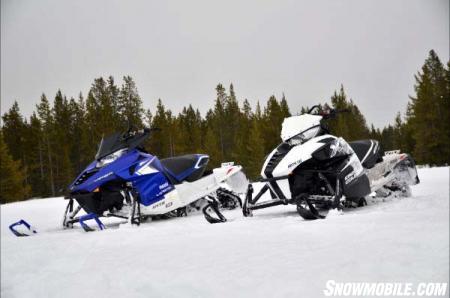
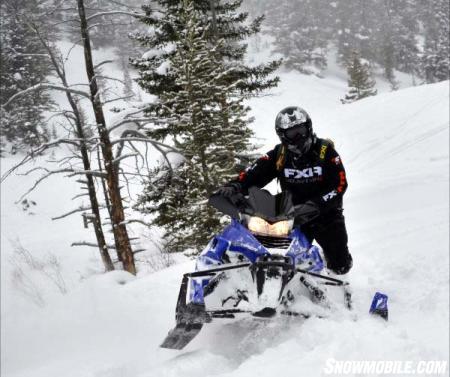





 Your Privacy Choices
Your Privacy Choices